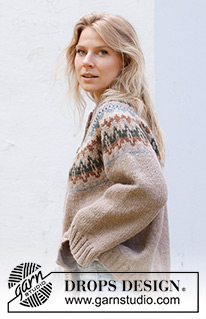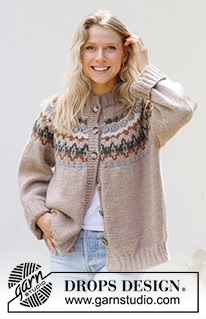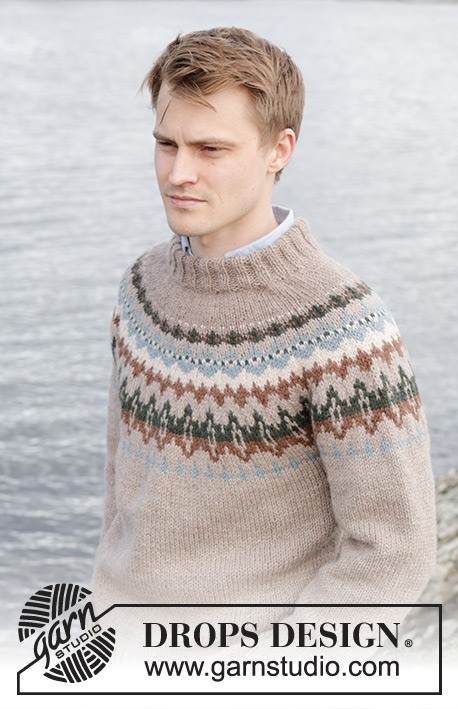Comments / Questions (4)
![]() Irene Rameckers wrote:
Irene Rameckers wrote:
Bestaat er een filmpje over wat gedraaid breien is?
17.09.2024 - 06:35DROPS Design answered:
Dag Irene,
In een van de video's die bij het patroon staat, wordt dit getoond. Deze video heet 'Hoe meerdert u met een omslag (omsl). In de tweede helft van de video zie je de eerste omslag niet gedraaid gebreid wordt op de averechte kant en hoe de tweede omslag gedraaid gebreid wordt. Als je de omslag gedraaid recht wilt breien op de volgende naald, dan steek je de naald in de achterste lus.
17.09.2024 - 20:20
![]() Anneke Van Wijk wrote:
Anneke Van Wijk wrote:
Er staat een fout in bij de mouwen. Het minderen bij de mouw kan nooit oom de 14 cm zijn bij maat S. Als de mouw 33 cm is een je moet 3x minderen, kom je nooit uit. Het klopt ook niet vergeleken met de andere maten. Ik denk dat jullie bedoelen om de 8 cm. Zoiets. Groetjes, Anneke
17.06.2024 - 07:07
![]() Karina Haupt Larsen wrote:
Karina Haupt Larsen wrote:
Dream catcher
05.08.2023 - 19:30
![]() Cindy Newhouse wrote:
Cindy Newhouse wrote:
Dream catcher
04.08.2023 - 15:43
Autumn Reflections Cardigan#autumnreflectionscardigan |
||||||||||||||||||||||
 |
 |
|||||||||||||||||||||
Knitted jacket in DROPS Nepal. The piece is worked top down with round yoke, multi-colored pattern and double neck. Size S - XXXL.
DROPS 244-23 |
||||||||||||||||||||||
|
------------------------------------------------------- EXPLANATIONS FOR THE PATTERN: ------------------------------------------------------- GARTER STITCH (worked back and forth): Knit all rows. 1 ridge = knit 2 rows. PATTERN: See diagrams A.1 to A.6. The diagrams show all rows in the pattern from the right side. The whole pattern is worked in stockinette stitch. INCREASE TIP (evenly spaced): To work out how to increase evenly, count the total number of stitches on the needle (e.g., 96 stitches) minus the bands (e.g., 14 stitches) and divide the remaining stitches by the number of increases to be made (e.g., 14) = 5.8. In this example, increase by making 1 yarn over after alternately each 5th stitch and 6th stitch (approx.). Do not increase over the bands. On the next row work the yarn overs twisted to avoid holes. EDGE STITCHES: Work 2 edge stitches at the beginning of the row: Slip the first stitch purl-wise with the strand in front, knit 1. Work 2 edge stitches at the end of the row: Work until there are 2 stitches left, slip 1 stitch purl-wise with the strand in front, knit 1. Repeat at the beginning and end of all rows. BUTTONHOLES: Work buttonholes on the right band (when the garment is worn). Work from the right side when there are 5 stitches left on the row as follows: Make 1 yarn over, knit 2 together and knit 3. On the next row (wrong side), knit the yarn over to leave a hole. The first buttonhole is worked when the neck is finished. Then the other 5-5-6-6-6-6 buttonholes are worked with approx. 10-10-9-9-10-10½ cm = 4"-4"-3½"-3½"-4"-4⅛" between each one. KNITTING TIP: To avoid the knitting gauge losing its elasticity when working pattern, it is important that the strands at the back are not tight. Use a size larger needle when working pattern if the piece becomes tight. DECREASE TIP (for sleeves): Decrease 1 stitch on each side of the marker-thread as follows: Work until there are 3 stitches left before the marker-thread, knit 2 together, knit 2 (marker-thread sits between these 2 stitches), slip 1 stitch knit-wise, knit 1 and pass the slipped stitch over the knitted stitch. ------------------------------------------------------- START THE PIECE HERE: ------------------------------------------------------- JACKET – SHORT OVERVIEW OF THE PIECE. The neck and yoke are worked back and forth with circular needle, from mid front and top down. The yoke is divided for body and sleeves and the body continued back and forth with circular needle. The sleeves are worked in the round with double pointed needles/short circular needle, top down. DOUBLE NECK: Cast on 84-88-92-96-100-104 stitches with circular needle size 4.5 MM = US 7 and color camel DROPS Nepal. Purl 1 row (= wrong side). Work as follows from the right side: 1 GARTER STITCH – read description above, * knit 2, purl 2 *, work from *-* until there are 3 stitches left, knit 2 and 1 garter stitch. Continue this rib back and forth for 5 cm = 2". Cast on 6 stitches at the end of the next 2 rows = 96-100-104-108-112-116 stitches. Then work as follows from the right side: 2 EDGE STITCHES – see description above, 5 garter stitches (= 7 band stitches), * knit 2, purl 2 *, work from *-* until there are 9 stitches left, knit 2, 5 garter stitches and 2 EDGE STITCHES (= 7 band stitches). Continue this rib for 5 cm = 2" (10 cm = 4" rib in total). Work as follows from the right side: 7 band stitches as before, knit 82-86-90-94-98-102 and increase 14-18-20-24-26-28 stitches evenly over these stitches – read INCREASE TIP, 7 band stitches as before = 110-118-124-132-138-144 stitches. YOKE: Change to circular needle size 5.5 MM = US 9. Remember the BUTTONHOLES – read description above. Work stockinette stitch, with 7 band stitches on each side and color camel, for 4 cm = 1½". On the next row from the right side increase 15-19-21-25-27-29 stitches evenly spaced = 125-137-145-157-165-173 stitches. Purl back from the wrong side (band stitches as before). Read KNITTING TIP and work as follows from the right side: 7 band stitches as before, work A.1, A.2 until there are 11 stitches left, work A.3 and 7 band stitches as before. The bands are worked with color camel as far as the row with the arrow in A.2, then with color beige (if beige is not used in the pattern, twist the strand between the band and the front piece to avoid a hole. To avoid carrying the strand across the row you can use a separate small ball for the bands on each side). On the last row in A.1/ A.2 / A.3 increase 0-4-2-6-4-2 stitches evenly spaced = 233-261-275-303-317-331 stitches. Then work as follows: 7 band stitches as before, A.4, A.5 until there are 13 stitches left, work A.6 and 7 band stitches as before. When A.4, A.5 and A.6 are finished there are 265-297-313-345-361-377 stitches. Continue with stockinette stitch and the bands as before in color beige. When the yoke measures 25-25-26-26-28-30 cm = 9¾"-9¾"-10¼"-10¼"-11"-11¾" (measure from after the neck), divide for the body and sleeves as follows: Work 46-50-52-58-62-65 stitches as before (front piece), place the next 48-56-60-64-64-66 stitches on 1 thread for the sleeve, cast on 6-6-8-8-10-12 stitches (in side under sleeve), work 77-85-89-101-109-115 stitches (back piece), place the next 48-56-60-64-64-66 stitches on 1 thread for the sleeve, cast on 6-6-8-8-10-12 stitches (in side under sleeve), work the remaining 46-50-52-58-62-65 stitches as before (front piece). The body and sleeves are finished separately. THE PIECE IS NOW MEASURED FROM HERE! BODY: = 181-197-209-233-253-269 stitches. Continue stockinette stitch and 7 band stitches in color beige for a further 29-31-32-34-34-34 cm = 11⅜"-12¼"-12½"-13⅜"-13⅜"-13⅜". Work 1 row from the right side and increase 19-19-19-23-27-27 stitches evenly spaced (do not increase over the bands) = 200-216-228-256-280-296 stitches. Change to circular needle size 4.5 MM = US 7 and work as follows from the wrong side: 7 band stitches as before, * purl 2, knit 2 *, work from *-* until there are 9 stitches left, purl 2 and 7 band stitches as before. Continue this rib for 6 cm = 2⅜". Bind off a little loosely with knit from the right side. The jacket measures approx. 64-66-68-70-72-74 cm = 25¼"-26"-26¾"-27½"-28⅜"-29⅛" from the shoulder. SLEEVES: Place the 48-56-60-64-64-66 stitches from the thread on the one side of the piece on short circular needle/double pointed needles size 5.5 MM = US 9 and knit up 1 stitch in each of the de 6-6-8-8-10-12 stitches cast on under the sleeve = 54-62-68-72-74-78 stitches. Insert a marker-thread in the middle of the new stitches under the sleeve. Start at the marker-thread and work stockinette stitch in the round with color beige. When the sleeve measures 3 cm = 1⅛", decrease 2 stitches under the sleeve – read DECREASE TIP. Decrease like this every 14-6½-4½-3½-4-3 cm = 5½"-2½"-1⅝"-1¼"-1½"-1⅛" a total of 3-5-6-8-7-9 times = 48-52-56-56-60-60 stitches. Continue working until the sleeve measures 33-33-33-33-31-30 cm = 13"-13"-13"-13"-12¼"-11¾" from the division (or to desired length. There is approx. 6 cm = 2⅜" left). Knit 1 round and increase 8-8-8-8-8-8-8 stitches evenly spaced = 56-60-64-64-68-68 stitches. Change to double pointed needles size 4.5 MM = US 7 and work rib (knit 2, purl 2) for 6 cm = 2⅜". Bind off a little loosely with knit. The sleeve measures approx. 39-39-39-39-37-36 cm = 15¼"-15¼"-15¼"-15¼"-14½"-14¼" from the division. Work the other sleeve in the same way. ASSEMBLY: Fold the neck double to the inside and sew down. To avoid the neck being tight and rolling outwards, it is important that the seam is elastic. Sew the openings on the bands with small stitches. Sew the buttons onto the left band. |
||||||||||||||||||||||
Diagram explanations |
||||||||||||||||||||||
|
||||||||||||||||||||||

|
||||||||||||||||||||||

|
||||||||||||||||||||||

|
||||||||||||||||||||||
Have you finished this pattern?Tag your pictures with #dropspattern #autumnreflectionscardigan or submit them to the #dropsfan gallery. Do you need help with this pattern?You'll find 33 tutorial videos, a Comments/Questions area and more by visiting the pattern on garnstudio.com. © 1982-2025 DROPS Design A/S. We reserve all rights. This document, including all its sub-sections, has copyrights. Read more about what you can do with our patterns at the bottom of each pattern on our site. |
||||||||||||||||||||||


























































































Post a comment to pattern DROPS 244-23
We would love to hear what you have to say about this pattern!
If you want to leave a question, please make sure you select the correct category in the form below, to speed up the answering process. Required fields are marked *.